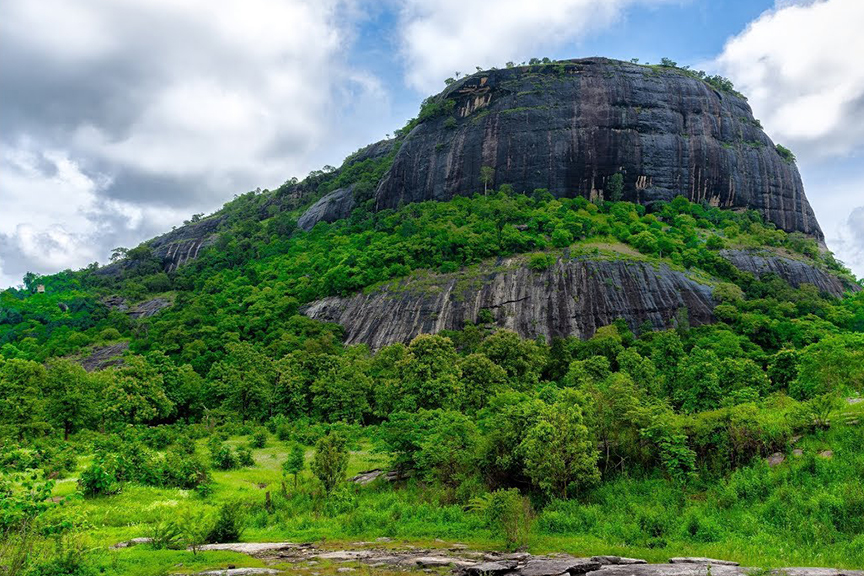Nuwaragala Mountain – geographically significant remnant mountain – By Arundathie Abeysinghe
 Significant as a remnant mountain belonging to *Gal Oya Mountain Range, Nuwaragala Mountain is 658 meters high. Located in Pollebedda village (s well-known village of *Vedda community) in Mahaoya Divisional Secretariat Division in the*Ampara District, currently, the location is under the purview of the Department of Forest Conservation. Several decades ago, the location was inhabited by Vedda community. There are large numbers of ancient tank walls, ponds, stone steps and ruins of several temples including cave temples that have not been formally researched, yet. There is a large cave with dripstones with inscriptions. There are also large numbers of stone pillars on the ground. Hence, the surrounding area is archeologically significant.
Significant as a remnant mountain belonging to *Gal Oya Mountain Range, Nuwaragala Mountain is 658 meters high. Located in Pollebedda village (s well-known village of *Vedda community) in Mahaoya Divisional Secretariat Division in the*Ampara District, currently, the location is under the purview of the Department of Forest Conservation. Several decades ago, the location was inhabited by Vedda community. There are large numbers of ancient tank walls, ponds, stone steps and ruins of several temples including cave temples that have not been formally researched, yet. There is a large cave with dripstones with inscriptions. There are also large numbers of stone pillars on the ground. Hence, the surrounding area is archeologically significant.
Situated along *Mahiyangane-*Dimbulagala-Dalukkane Road, a paved pathway constructed out of stone leads to the summit of the mountain and to a large cave that can house approximately 150 people. The cave has been partitioned with brick walls and has had a plastered and decorated interior but the walls and the inner plaster is in ruins, at present.
Scholars are of the view that Nuwara Gala was once the kingdom of *King Saddatissa, brother of *King Dutugemunu. There are ruins of an old castle and a rock pool constructed on top of the mountain. According to some historians, King Saddatissa’s son, King Lajjatissa has constructed temples at the location. According to scholars, “Nuwara Gala” is the site of the ruins of a large (ancient) city that must have been the administrative center during that era.
Some historians are of the view that the site had been an ancient palace approximately 200 years before the monastery was constructed.
The ruins of the monastery located in Nuwaragala Mountain and the surrounding area displays the prosperity of the monastery that had existed during the first century BC. Among the most prominent ruins, there are ruins of a Statue House that would have been constructed approximately 300 years after the initial construction of the monastery.
The pond at the summit of the mountain that exists in its pristine glory to date would have been initially constructed to cater to hundreds of *Arhat monks. Considered as an infinity pool by tourists due to its shape, according to villagers, the pond at the top of the mountain never runs dry. It is a mesmerizing sight…
As the location of Nuwaragala Mountain is associated with the Vedda community, the caves in the mountainous forest also includes cave paintings done by Vedda community. According to scholars, an ancient group known as “Heethala Vanni” had lived in the jungle adjacent to the mountain. R.L. Spittle, a renowned physician and anthropologist has written about these indigenous people in his book “Vanished Trails: The Last of the Veddas” (describing their transition from the troglodyte, food-gathering stage to the beginnings of the hut-dweller and food-producer).
From the summit of the mountain, several mountains such as Pettigala Mountain, Savula Hela, Ethbedda, Walas Mountain as well as Gal Oya Mountain Range can be seen. The tanks Nuwaragala Tenna Wewa, Borupola Wewa, Rukam Wewa, Weligahakandiya Wewa and Rambaken Oya Reservoir extending to the east coast of Sri Lanka can also be seen. Hence, the vistas from the location are breathtaking….
Nuwaragala is considered as a marvel of nature…
Directions: Travel up to *Mahiyangana and thereafter up to Padiyathalawa and Mahaoya. From there, it is necessary to walk approximately four kilometers to the foothills and climb another 2-3 kilometers from the foot of the mountain.
- Ampara – Located in the Eastern Province of Sri Lanka 360 kilometers east of Colombo, Ampara is the main town of Ampara District.
- Anuradhapura – A major city in Sri Lanka (former Ceylon), the capital of Anuradhapura District. Anuradhapura is famous for its well-preserved ruins of Sri Lankan civilization. Founded in the 4th century, Anuradhapura was the capital of Sri Lanka until the beginning of the 11th century. Anuradhapura is considered sacred to Buddhists and there are monasteries, stupas within an area of 40 square kilometers. Situated 205 kilometers north of Colombo, Anuradhapura was declared as the “Sacred City of Anuradhapura” and a World Heritage Site by UNESCO in 1982.
- Arhat – The term Arhat refers to a pious Buddhist monk who has gained insight into the true nature of existence and has achieved Nirvana (release from the cycle of death and rebirth, the ultimate spiritual goal of Buddhism).
- Badulla – Situated in lower central hills, Badulla is the capital city of Uva Province and Badulla District.
- Mahiyangana – A town situated in *Badulla District of Uva Province, Sri Lanka.
- Dimbulagala – Also known as “Gunner’s Quoin” or “Gunner’s Rock” during the British Colonial Era, this is a rock formation located in the *Polonnaruwa District. According to historical records, when anthropologist Charles Gabriel Seligman visited the location in 1911, a cave within the rock had become a refuge of the indigenous Veddas. During the 12th century AD, Sinhalese people in the hamlet had constructed a Buddhist Monastery within the rock formation known as “Dimbulagala Raja Maha Viharaya”.
- Gal Oya– Resplendent with forest and lush mountains and located 376 kilometers northeast from Colombo in Badulla District with part of it stretching into *Ampara District, Gal Oya is a 108 kilometers long river in South east Sri Lanka beginning in the hills east of Badulla and flows northeast.
- King Dutugemunu – Also known as “Duttagamini” was born to a royal family in southern Sri Lanka. His parents were King Kavantissa and Princess Vihara Maha Devi. Prince Dutugemunu became King Dutugemunu (164 BC – 140 BC). His brother was Prince Saddha Tissa who later reigned as the king of *Anuradhapura (137 BC-119 BC).
- Polonnaruwa – Main town of Polonnaruwa District in North Central Province of Sri Lanka, Polonnaruwa was Sri Lanka’s kingdom from 1055 to 1232.
- Veddas – Also spelt as “Veddhas” and at present known as “Adivasi” or “Wanniyalaeto”, they are a dwindling minority indigenous community in Sri Lanka. They were Sri Lanka’s (former Ceylon) aboriginal inhabitants prior to the 6th century bce. They take immense pride in an age-old lifestyle of hunting and collecting firewood from the forest. According to anthropologists, their origins are much older; with some anthropologists dating them to the Stone Age. A hunter-gather community, Veddas have a long history of living harmoniously with nature.









